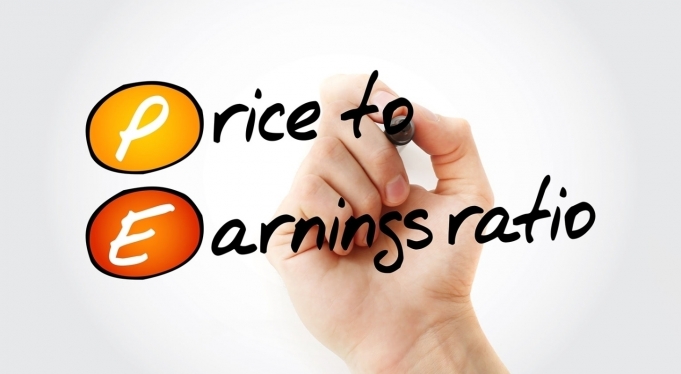What is the P/E Ratio?
The price-to-earnings ratio, or otherwise known as the “P/E” ratio, is a financial metric commonly used to measure how expensive a stock is compared to its earnings. The ratio can be rephrased as the amount that an investor is willing to pay for every $1 of earnings for a specific company. The ratio involves two components; the first is the ‘P’ portion, which is the current price per share of the stock, and the second is the ‘E’ portion, which is the Earnings Per Share (EPS) of the stock. For example: if Stock A has a current price per share of $30, and an EPS of $1, then the P/E ratio is 30X (calculated as: $30 Price / $1 EPS = 30X P/E). To maintain a stable P/E ratio over time, the price must appreciate at the exact same rate as the earnings per share. For instance, for the P/E to remain at 30X in the next year, if the share price increases by 10% from $30 to $33, then the EPS must also increase by 10% from $1 to $1.1 (calculated as $33 Price / $1.1 EPS = 30X P/E).
The Difference Between Trailing P/E and Forward P/E
Both Forward and Trailing P/E involve the same two components: price per share and EPS. While both Forward and Trailing P/E use the current price per share of the stock, the timeframe for the EPS differs.
• Trailing P/E is calculated as: price per share / trailing 12-month EPS
• Forward P/E is calculated as: price per share / expected forward 12-month EPS
Let’s break down what the differences are between the trailing 12-month EPS used in the Trailing P/E calculation, and the expected forward 12-month EPS used in the Forward P/E calculation. The trailing 12-month EPS is simply the EPS of the stock over the most recent 12 months. On the other hand, the expected forward 12-month EPS is driven by analyst expectations of the company’s earnings over the next 12 months.
Since the Trailing P/E uses the EPS from the past 12 months, this metric tells the investor how expensive the shares are for every $1 of earnings as of today. Whereas the Forward P/E uses the EPS of the next 12 months, this metric tells the investor how expensive the shares will be one year from today. As a rule of thumb, if the Forward P/E ratio is less than the Trailing P/E ratio, this implies that the company’s earnings are expected to grow, and vice versa if the Forward P/E ratio is higher than the Trailing P/E.
Benefits of Using Trailing P/E
1. Trailing P/E is most commonly used when referencing the value of a stock. It is particularly useful when assessing the current valuation of one stock against its peer. For example: if Stock A and Stock B are identical, then one would believe that both stocks should be valued equally in terms of Trailing P/E
Pitfalls of Using Trailing P/E
1. If the Trailing P/E is used to compare a stock against its peers, and comparatively the stock seems undervalued compared to its peers, this may not mean that the stock is truly undervalued, there may be very good reasons that the stock is trading at a lower valuation.
2. As it is only reflecting the previous 12 months of earnings, it can be misleading if the prior year was exceptionally good or exceptionally bad
3. The expectation for a Trailing P/E can be an arbitrary number, for example, the price at which someone is willing to pay for a stock is not always indicative of the true underlying value
4. If a company is trading at what is considered a ‘high P/E’, this may not necessarily mean that the stock is overpriced, as the price of the stock can continue to increase and if the earnings increase at a faster rate, then the P/E ratio will decrease
5. Markets are forward-looking, and so using a trailing P/E is a bit like driving a car using only your rear-view mirror. A forward P/E should give a better indication of the outlook of the company, whereas the historical data should be priced in
Benefits of Using Forward P/E
1. The Forward P/E provides context into how much the company is expecting to grow in the next year, and whether the P/E ratio will become more digestible to an investor
2. Eliminates the use of any outliers within the past 12 months in the event of a banner year or exceptionally poor year
Pitfalls of Using Forward P/E
1. Forward EPS values are estimates derived from many assumptions used by analysts, and as such, are only as reliable as the estimates
2. As well all know, the future is unpredictable, and any outlier event can cause the actual EPS to deviate from the forward EPS estimates
Conclusion
The P/E ratio can be a very useful metric in determining the valuation of a stock and its price compared against another stock. Both Trailing and Forward P/E can be used when assessing a stock and it is up to the investor to determine which metric is most appropriate. Both metrics can be useful, and each has its merits in certain situations. However, when available, we think an investor should opt for a forward P/E ratio over the trailing P/E because markets are forward-looking and anticipating what is going to happen a year ahead, rather than what happened last year.
Research for today, invest for tomorrow.

Thinking about becoming a 5i Research Member? If so, no need to wait! Start your free trial today, and see for yourself how 5i Research can help you elevate your Investment Game.







Comments
Login to post a comment.